Step-by-Step Projects & Techniques DENISE PECK Editor of
Step by Step Wire Jewelry TECH EDITOR
TECH EDITOR Jamie Hogsett
PHOTOGRAPHY Joe Coca
DESIGN Liz Quan
PRODUCTION Katherine Jackson 2009 Interweave Press LLC Photography 2009 Interweave Press LLC Unless otherwise noted, all projects made by Denise Peck. All rights reserved.
 | Interweave Press LLC 201 East Fourth Street Loveland, CO 80537 Interweavestore.com |
Library of Congress Cataloging-in-Publication Data Peck, Denise. 101 wire earrings : step-by-step techniques and projects / Denise Peck. p. cm.
Includes bibliographical references and index. ISBN 978-1-59668-141-5 (pbk.) ISBN 978-1-59668-501-7 (PDF) ISBN 978-1-62033-193-4 (ePub) 1. Jewelry making. 2. Wire craft. Earrings. I. Title. II. II.
Title: One hundred one wire earrings. TT212.P4245 2009 739.27dc22
Dedication
For my mother, who told me, when I was a teenager, that I should learn to make jewelry. And who, at ninety-one, is still as excited about going to a bead show as I am. Denise Peck

Table of Contents





Chances are, if youre a jewelry lover, you frequently find yourself browsing jewelry departments and marveling at all the beautiful earrings. And probably on more than one occasion youve whispered to yourself, I could make that. Well, youre right! Almost all pierced earrings are made of only two design elements: a dangle, or stationary decoration, and an ear wire, or post.
And they all use wire. Once you know a few basic rules about working with wire and the elementary steps for making the key pieces, the skys the limit! Have you heardyou can never have too many earrings! Whether youre already a jewelry maker or youre just venturing into the world of beads and wire, youll find earring designs here that will tickle your creativity. With the resources given for each project, you can follow along step by step, or you can throw in some of your own beads or found objects and make them your very own. As a bonus, many of the designs featured include an easy suggestion for another option for a quick change-up to the look. You probably already own some of the basic tools required: a chain-nose pliers, which are just like needle-nose pliers, but without teeth; a ball-peen hammer; a wire cutter. Most of the designs in this book can be made with three or four simple tools.
Theres a comprehensive glossary of toolsthose you definitely need, and some you may want to add to your toolbox. Because almost every pair of earrings uses ear wires, Ive included a of clearly photographed instructions for making several different ear wire designs, along with matching head pins. This section also outlines the rest of the simple wireworking processes you need to make all 101 designs. The projects are conveniently labeled by skill level. If you master the simple ones, you can easily work your way through to the more challenging designs. Or, you can flip through all the projects, mark your favorites and dive right in.
Either way, everything you need to learn how to make just about any pair of earrings is right here. So take another shopping trip and know that, yes, you can definitely make that pair of earrings! 
One of the best things about working with wire is that its such a forgiving medium. If you make a mistake, you can often restraighten the wire and begin again. Additionally, you can buy practice wire very inexpensively and create with impunity! Copper, brass, and colored craft wire are available in hardware and craft stores, and all of them can produce finished pieces every bit as beautiful as sterling silver and gold. Wire comes in a large variety of metals, shapes, and sizes. The size or diameter of wire is known as the gauge.
In the United States, the standard is Brown & Sharpe, also known as American Wire Gauge (AWG). The diameter of wire in inches or millimeters is translated into a numeral from 0 to 34, the higher the number, the thinner the wire. Most of the projects in this book use wire in 14 gauge through 24 gauge. Wire also comes in a variety of shapes. You can buy round, half-round, and square wire. Round is most commonly used and easily availableall projects in this book call for round wire unless otherwise instructed.
Half-round has a flat side and is commonly used for ring shanks, and square wire has four flat sides. Both half-round and square wire must be ordered from a jewelers supplier. In most cases, the choice of shape is purely aesthetic. Additionally, a jewelers supplier will offer wire in three hardnesses: dead-soft, half-hard, and full-hard. Dead soft wire is best if youre going to be manipulating it a lot because wire work-hardens as you work with it. Work-hardening stiffens the wire and makes it harder to bend.
Eventually it can become so brittle that it can break with additional manipulation.  If youre weaving, coiling, or spiraling, you should work with dead-soft wire, as its much easier on the hands. If youre making ear wires or not planning on working the wire too much, you can start with half-hard wire, which is already stiffer than dead-soft wire. There are no projects in this book that call for full-hard wire. You can make jewelry out of both base-metal wire and precious-metal wire. The most common base-metal wire used in jewelry is copper, though aluminum, nickel silver, and brass are also available.
If youre weaving, coiling, or spiraling, you should work with dead-soft wire, as its much easier on the hands. If youre making ear wires or not planning on working the wire too much, you can start with half-hard wire, which is already stiffer than dead-soft wire. There are no projects in this book that call for full-hard wire. You can make jewelry out of both base-metal wire and precious-metal wire. The most common base-metal wire used in jewelry is copper, though aluminum, nickel silver, and brass are also available.
Sterling silver and gold wire are precious metals. The cost of gold wire is often prohibitive, so a common alternative is gold-filled wire, which is base-metal wire covered with an outer layer of gold. Gold-filled wire is preferable to gold-plated wire because gold plating scratches and wears off easily. As with the shape of the wire, the choice of metal is usually just a matter of personal preference.  Download this chart as a PDF.
Download this chart as a PDF.
Many of the earring designs in this book require five simple tools; a set of pliers, wire cutters, a ring mandrel, a large stepped mandrel and a coiling tool.
As you become more adept at jewelry making, you may want to expand your toolbox to include some of the tools below. Tool prices reflect the quality of the tools youre buying, and range from very inexpensive to very expensive. A good set of pliers will be the best investment you can make. GENERAL General tools range from basic necessities like flush cutters to mandrels for forming and gauges for measuring.


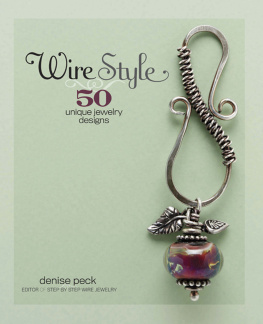

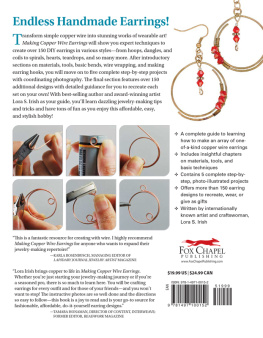


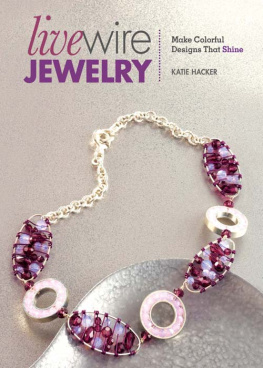
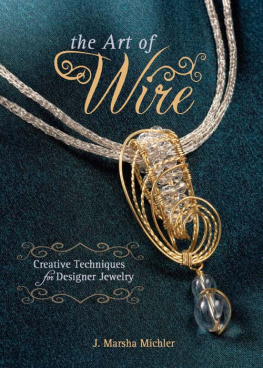
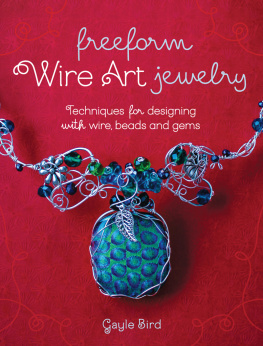
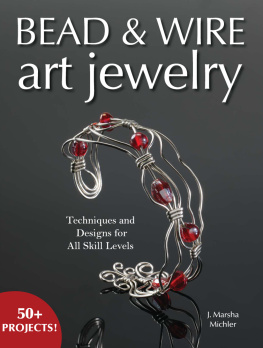
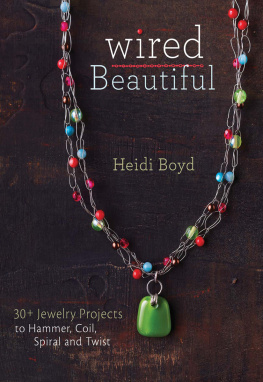
 TECH EDITOR Jamie Hogsett PHOTOGRAPHY Joe Coca DESIGN Liz Quan PRODUCTION Katherine Jackson 2009 Interweave Press LLC Photography 2009 Interweave Press LLC Unless otherwise noted, all projects made by Denise Peck. All rights reserved.
TECH EDITOR Jamie Hogsett PHOTOGRAPHY Joe Coca DESIGN Liz Quan PRODUCTION Katherine Jackson 2009 Interweave Press LLC Photography 2009 Interweave Press LLC Unless otherwise noted, all projects made by Denise Peck. All rights reserved. 





 Chances are, if youre a jewelry lover, you frequently find yourself browsing jewelry departments and marveling at all the beautiful earrings. And probably on more than one occasion youve whispered to yourself, I could make that. Well, youre right! Almost all pierced earrings are made of only two design elements: a dangle, or stationary decoration, and an ear wire, or post.
Chances are, if youre a jewelry lover, you frequently find yourself browsing jewelry departments and marveling at all the beautiful earrings. And probably on more than one occasion youve whispered to yourself, I could make that. Well, youre right! Almost all pierced earrings are made of only two design elements: a dangle, or stationary decoration, and an ear wire, or post. 
 If youre weaving, coiling, or spiraling, you should work with dead-soft wire, as its much easier on the hands. If youre making ear wires or not planning on working the wire too much, you can start with half-hard wire, which is already stiffer than dead-soft wire. There are no projects in this book that call for full-hard wire. You can make jewelry out of both base-metal wire and precious-metal wire. The most common base-metal wire used in jewelry is copper, though aluminum, nickel silver, and brass are also available.
If youre weaving, coiling, or spiraling, you should work with dead-soft wire, as its much easier on the hands. If youre making ear wires or not planning on working the wire too much, you can start with half-hard wire, which is already stiffer than dead-soft wire. There are no projects in this book that call for full-hard wire. You can make jewelry out of both base-metal wire and precious-metal wire. The most common base-metal wire used in jewelry is copper, though aluminum, nickel silver, and brass are also available. Download this chart as a PDF.
Download this chart as a PDF.